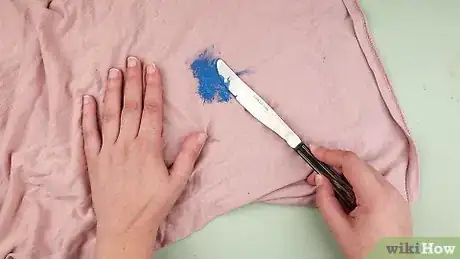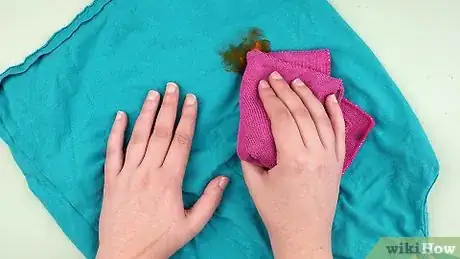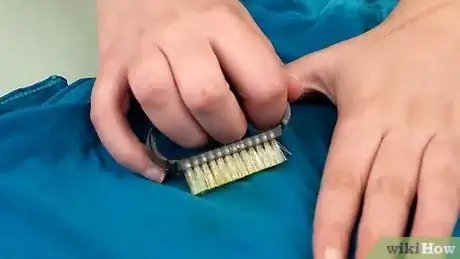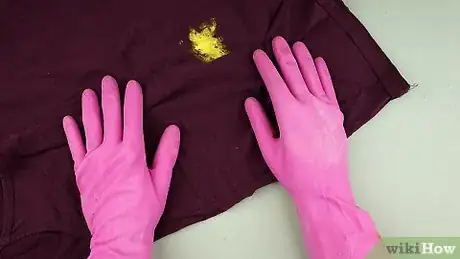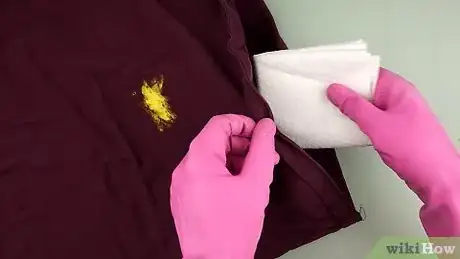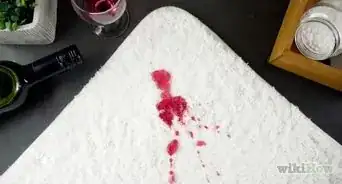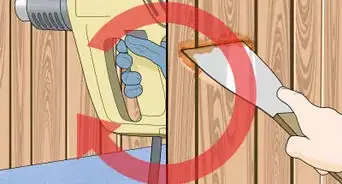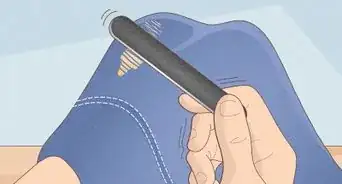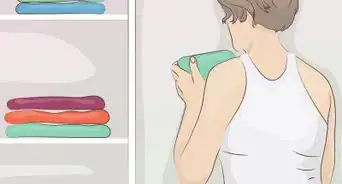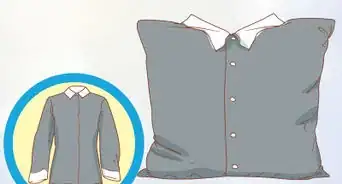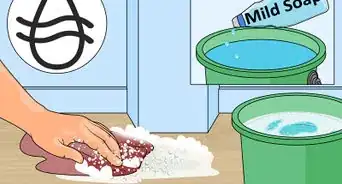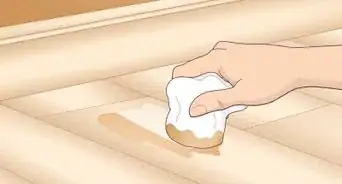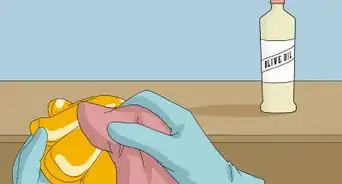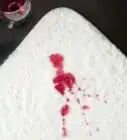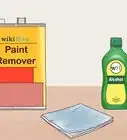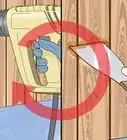This article was co-authored by Kamel Almani. Kamel Almani is a Laundry and Cleaning Specialist and the Co-Owner of WashyWash, a toxin-free and eco-friendly laundry and dry clean service based in Amman, Jordan. Kamel and his staff at WashyWash use Blue Angel certified and dermatologically-tested detergents. They also combine EcoClean and digital technology to provide an eco-friendly, convenient, and quality cleaning service. Kamel holds a BA in Design from the University of Applied Science, Amman.
There are 7 references cited in this article, which can be found at the bottom of the page.
This article has been viewed 838,853 times.
Did you drip paint on your favorite shirt? Accidentally rub against a newly painted wall? Regardless of how it happened, you may have a pretty tough stain to deal with if you've gotten paint on your clothing. Work quickly if you see that the paint hasn't set yet. It's much harder to remove paint from your fabrics after it's dried. If you deal with the paint while it's still wet, you may be able to remove it completely without too much hassle.
Steps
Using Hairspray
-
1Wipe any excess or remaining wet paint from the affected area. If you know that you've used a latex-based paint, and the paint has already dried significantly, then you definitely want to use hairspray to remove the stain. You should still wipe off any excess paint that you can, but your stain is probably more deeply set if you're using hairspray. Use a knife or other sharp object to scrape off more deeply set paint.
- While latex paint comes out of fabrics much more easily than oil-based paint, it will dry more quickly. Within one or two hours, the paint will dry completely. This is when you should resort to using hairspray. If you catch a latex paint stain before it dries, scrub it with soap and water. After a few rinses and a trip through the washing machine, it will probably be removed.
-
2Spray hairspray on the affected area. If you don't have hairspray, then you can use a pure isopropyl alcohol, otherwise known as rubbing alcohol[1] . This is the active compound in the hairspray that will break down the stain, meaning that either method will work in the same fashion. You can give the hairspray a couple of minutes to set in. Make sure that you've really doused the problem area in hairspray. It should feel quite moist, as you'll need quite a bit to break down the stain if it's already set.Advertisement
-
3Scrub gently with a brush or washcloth. If you rub too harshly, you'll damage your fabric permanently. You should see the paint starting to loosen or liquify from the affected area. If the hairspray isn't changing color at all, then you may have not applied enough, or the alcohol base may not be strong enough. Continue scrubbing until you notice a reduction of the stain's size or pigmentation.
- If you're not seeing immediate results with the use of hairspray, then you may have to purchase some proper rubbing alcohol to fully get rid of the stain. You can repeat this process in the exact same fashion that you would with hairspray.
-
4Run the garment through the laundry. After you've successfully removed some of the paint by scrubbing, you can run a normal wash on your damaged article of clothing. Even if the stain hasn't disappeared completely, you've definitely loosened it, and more of the stain should wash out with a rinse.
- You also can apply a bit of detergent and water to the stain after applying the hairspray. Because latex paint does not react negatively to water, you won't run into the same "gumming" problems that you would with oil-based paint.
Using a Simple Detergent
-
1Wipe off any remaining wet paint that may still be on the fabric. The detergent method will work best if it hasn't set in completely yet. It's also the easiest to pull off on the fly, as most people should have detergent on hand, whether you're at home or at work. If you don't have any detergent available, you can try using bar or liquid soap. It may not be as effective, but you definitely want to attempt to clean the fabric before the paint dries.
-
2Flush the back of the fabric with warm water. You should rinse from behind the stain, isolating the section that's been covered. If the stain has come from a watercolor or kids' tempera paint, it will probably start to rinse out fairly quickly.[2] These washable paints don't always come out immediately, but you'll definitely start to see some color bleeding out of the fabric. Check the paint bottle to see if you have a washable paint. If you do, you'll have a much easier time cleaning the stain, and you may just have to rinse with water and can skip using the detergent.
-
3Mix together equal parts of dish detergent and warm water. Before starting to apply to your clothing, you'll want to check the labels of your garment and your detergent to ensure that they're compatible.If you're not totally sure, apply the mixture to an inconspicuous area of your garment. This way, you can check the viability of your mixture without damaging your clothes irreparably. Soak a clean sponge in the detergent and water mixture. Be sure not to use a paper towel or cotton cloth. The fibers will get stuck and rub off in your clothing, creating a larger mess.
- Always put a cloth or fabric underneath your damaged clothing. You don't want it to bleed onto the surface that you're operating on. Even if the paint is washable, you'll avoid staining your countertop or table with any excess color.
-
4Blot the front side of the garment with the soapy sponge. Remember that blotting is different than rubbing. If you rub at the fabric with your sponge, you'll essentially push the paint deeper into the fibers of your fabric. While you can be pretty vigorous with the blotting, you want to make sure you aren't permanently damaging your garment. You can also put the shirt between your fingers, rubbing the mixture gently into the fabric.
-
5Rinse the garment under warm water, again from the backside of the fabric. If you're cleaning a washable paint, then a good amount of pigment should be washing out from your fabric. Make sure that you aren't staining anything else with your dripping, including your sink. If there's excess paint and water in the garment, make sure to wring it into a separate bowl. You'll be able to dispose of it more easily.
-
6Repeat this process, blotting and rinsing the stained garment until the mark is more or less invisible. You might want to try using a bristled toothbrush to rub at the stained area. This can often be successful in releasing paint from the fibers of your clothes without rubbing the color any deeper into the fabric. Be cautious with this, however, as any excessive force may get the pigment stuck in the fabric.
-
7Rinse your garment using your washing machine. Running your stained article of clothing through a wash cycle can often get rid of the stain completely. You've loosened the paint using the detergent, so your washing machine will work much more efficiently. Without pre-treating the garment, however, the washing machine might not be able to fully eliminate your stain. Certain washable or water-based paints may not require this step.
- Don't wash your paint stained garment with another article of clothing, as the paint will bleed onto your other clothes. You don't want to damage your entire wardrobe just to save a single item.
- If the stain is still present after a wash cycle, place a bit of acetone on the front of the garment and blot with a clean sponge. Do not put acetone on fabrics that also contain acetate or triacetate, as it will melt these fabrics on contact. [3]
Using Paint Thinner or Turpentine
-
1Put on proper safety gear. Before you begin, remember that paint thinner is quite toxic.[4] When attempting to clean your stains, wear proper safety clothing, including gloves, safety goggles, and a respirator. If you're cleaning the stain while inside in your home, open a window to properly ventilate the fumes. This solvent is also very flammable, so be sure not to bring it near any sort of open flame.
- Even though turpentine is less toxic than most paint thinners, there's no harm in being safe and wearing the proper gear when cleaning fabric with it.
-
2Wipe off any and all paint that that you still can from the fabric. Paint thinner or turpentine works best for oil-based paints, especially if the paint has dried significantly. Oil-based paints are much harder to remove than water-based paints, but can still be attacked with a little bit of know-how.
- Keep in mind that oil-based paints take a significantly longer amount of time to dry than washable or latex paints.[5] After an oil-based paint has dried completely, it's a much larger pain to get rid of. If you notice an oil-based paint stain on your clothing, you should rub it out immediately. Your chance of saving the fabric will increase exponentially if you can treat these stains early.
- If the stain has set, you can even use a knife or other sharp object to scrape the dried paint from the fabric. Be careful not to stab into the garment and damage it.
-
3Pad the back of the fabric with a thick bit of paper towels or a cotton rag. This will help catch any paint that seeps through the back of the fabric. If the paint bleeds through to the other side of your garment, you may end up staining the other side of your fabric. You also don't want to damage the surface that you're working on. This especially important with oil-based paints, as they won't wash out nearly as easily as a latex or water-based paint.
- You will have to change out this backing pad a few times throughout the cleaning process. If the paint has bled through completely and stained the pad, then you won't be able to avoid staining other parts of your clothing. Make sure to be conscious of how much paint the pad has been absorbed. If you think the pad will start leaking soon, you should swap it out.
-
4Place paint thinner or turpentine directly on the affected area. Make sure that if you're using paint thinner, it's a thinner that matches directly to the paint that was used. Anything too volatile and flammable will most likely damage your fabric. You don't want to discolor your clothing in the process, then you have to be careful with the thinner that you choose. If don't know what sort of paint is responsible for the stain, then your best bet is to use turpentine.[6]
-
5Scrub the area with detergent. After you've treated the stained area properly with your paint thinner or turpentine, you'll want to apply detergent to it. Make sure that if your fabric can't be bleached, you don't use a detergent with bleach. You can apply the detergent liberally to the affected area, blotting it with a small sponge or cloth. Be careful not to rub too harshly, as you could push the paint deeper into the fabric.
- If you are still wearing your rubber gloves, you can use your fingers to apply the detergent. If not, don't let your bare skin touch the paint thinner. Many thinners can be quite toxic to your skin, and you want to avoid any potential risk.
-
6Let the garment soak overnight and run it through the laundry the next day. Fill a bucket with hot water and let your stained article sit overnight. Check the tag on your garment to check the maximum temperature that it can handle. When you wake up the next morning, you can run it through a normal laundry cycle. Be sure not to wash it with any other articles of clothing, as you run the risk of staining the rest of your load.
- If you see a significant change in the coloration after the first attempt, then it's worth repeating the process again.[7] If not, however, the stain may be permanent. This means you may have to throw the garment out. The more times that you apply the thinner or turpentine to the fabric, the larger the risk of further damage to the material.
Expert Q&A
-
QuestionHow do you get dried oil paint out of clothes?
 Kamel AlmaniKamel Almani is a Laundry and Cleaning Specialist and the Co-Owner of WashyWash, a toxin-free and eco-friendly laundry and dry clean service based in Amman, Jordan. Kamel and his staff at WashyWash use Blue Angel certified and dermatologically-tested detergents. They also combine EcoClean and digital technology to provide an eco-friendly, convenient, and quality cleaning service. Kamel holds a BA in Design from the University of Applied Science, Amman.
Kamel AlmaniKamel Almani is a Laundry and Cleaning Specialist and the Co-Owner of WashyWash, a toxin-free and eco-friendly laundry and dry clean service based in Amman, Jordan. Kamel and his staff at WashyWash use Blue Angel certified and dermatologically-tested detergents. They also combine EcoClean and digital technology to provide an eco-friendly, convenient, and quality cleaning service. Kamel holds a BA in Design from the University of Applied Science, Amman.
Laundry & Cleaning Specialist For oil-based paints, use an alcohol-based liquid like rubbing alcohol, then dab the spot with an absorbent towel. Then, wash the clothing separately as normal in the washing machine.
For oil-based paints, use an alcohol-based liquid like rubbing alcohol, then dab the spot with an absorbent towel. Then, wash the clothing separately as normal in the washing machine. -
QuestionHow can I remove paint from my cloth shoes?
 Community AnswerDepending on how long the paint has set into your cloth shoes, and also whether the paint is water based, oil based etc, you could try any of the methods outlined in this article. Regardless of the method, remember to blot the cloth fabric and avoid any harsh scrubbing, which will likely damage the fabric. Use old toothbrushes and be patient. It is better to see small results using repeated tries than to attack it with force and risk damaging the woven fibers of the cloth in a rush to get out the paint.
Community AnswerDepending on how long the paint has set into your cloth shoes, and also whether the paint is water based, oil based etc, you could try any of the methods outlined in this article. Regardless of the method, remember to blot the cloth fabric and avoid any harsh scrubbing, which will likely damage the fabric. Use old toothbrushes and be patient. It is better to see small results using repeated tries than to attack it with force and risk damaging the woven fibers of the cloth in a rush to get out the paint. -
QuestionHow can I remove silk paint from a t-shirt?
 Community AnswerYou can try using 1/2 cup of vinegar and 2 tablespoons of baking soda mixed together. You have to rub this mixture thouroghly with a sponge onto the surface of the shirt, and rinse it out to remove the silk paint.
Community AnswerYou can try using 1/2 cup of vinegar and 2 tablespoons of baking soda mixed together. You have to rub this mixture thouroghly with a sponge onto the surface of the shirt, and rinse it out to remove the silk paint.
References
- ↑ Kamel Almani. Laundry & Cleaning Specialist. Expert Interview. 9 April 2021.
- ↑ http://cleaning.tips.net/T004226_Removing_Paint_Stains.html
- ↑ http://www.goodhousekeeping.com/home/stain-buster/stains-paint-latex-may07
- ↑ https://www.truevalue.com/diy-projects/post/paint-and-stain/use-paint-thinner-properly
- ↑ http://www.burnettpainting.com/general-tips/how-long-does-it-take-for-paint-to-dry-cure/
- ↑ http://www.ukflooringdirect.co.uk/info/How_to_Remove_Paint_from_Carpet%3A_Simple_Steps.html
- ↑ http://www.howtocleanstuff.net/how-to-remove-oil-based-paint-stains/
About This Article
To remove fresh paint from fabrics, use a simple dish detergent. Start by wiping off any remaining wet paint, then flush the back of the fabric with warm water. Mix together equal parts of dish detergent and warm water, then soak a clean sponge in the mixture. Blot the front side of the garment with the soapy sponge, then rinse the area from the backside with warm water. Repeat blotting and rinsing until the stain is gone. If the stain is being stubborn, try using a bristled toothbrush to scrub the area. IF you want to learn how to use paint thinner to get the paint out of your fabric, keep reading the article!
